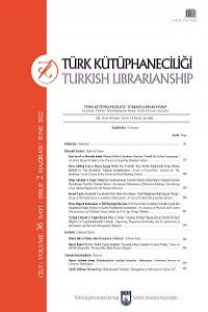Kâtip Çelebi’nin Keşfü’z-Zunûn’unda Sınıflama Yöntemi
İnsan zihni evrendeki bireylerin sayısız
çokluğunu kolayca kavrayamadığı için bireyler arasında bulduğu ortak
özelliklere dayanarak sınıflar oluşturur ve onları bu sınıflar yoluyla
sınırlayıp kavrayabilir. Sınıflama, sınıflama yapılan toplumun düşünsel yapısı
ve özelliklerini içinde taşır. Sınıflama, sınıflandırılanı değişik
yaklaşımlarla bilmeyi, anlamayı gerektirir. Yazı öncesi toplumlarda başlayan bu
yaklaşım felsefe ve bilim alanlarının olmazsa olmazı durumuna gelmiş; günümüz
arşivlerinde kurumsal yapıyı, kütüphanelerinde ise evrensel bilgiyi sınıflama
çalışmalarına dönüşmüştür.Bu
çalışmanın amacı, felsefe, bilim, kütüphane ve arşiv alanlarında sınıflamanın
genel tarihçesini belirlemek, İslâm Dünyası ve Osmanlı İmparatorluğu’ndaki
sınıflama çalışmaları ışığında Kâtip Çelebi’nin bibliyografik çalışması Keşfü’z-Zunûn’daki sınıflama olgusunu
açıklamaktır. Kâtip Çelebi’nin yapıtının seçilme nedenleri; yapıtın, Osmanlı
İmparatorluğu sınırları içinde yazılı literatüre yönelik çalışmaların,
özellikle bibliyografik araştırma ve saptama aşamasında ana başvuru kaynakları
arasında bulunması ve o dönem Osmanlı kütüphanelerinde kitap sayısı en çok üç
tanesinde beş bini bulurken, Kâtip Çelebi’nin Keşfü’z-Zunûn’unda 14.500 kitabın tanıtımının yer almasıdır.
Çalışmada Kâtip Çelebi’nin Keşfü’z-Zunûn’daki sınıflama içinde yer aldığı İslâm
ve Osmanlı İmparatorluğu kültüründen çok etkilendiği yönündeki hipotez,
belgesel tarama ve betimleme yöntemi ile doğrulanmaya çalışılmıştır. Nitekim bu
etkiyi Kâtip Çelebi’nin bibliyografik çalışmasında, gerek bilgi/bilim
sınıflanmasına ilişkin görüşleri gerekse yapıtın alfabetik ana düzeninde görmek
olanaklıdır.
Anahtar Kelimeler:
Sınıflama, İslâm dünyası, Osmanlı İmparatorluğu, Kâtip Çelebi, Keşfü’z-Zunûn
Classification Method in Kâtip Celebi’s Keşfü’z-Zunûn
The conception of the
countless beings in the universe individually is a state that transcends the
power and potentiality of the human mind. For this reason, the human mind
creates classes based on some common characteristics found among the countless
beings, and limits and conceives them through these classes. The classification
contains within itself the intellectual structure and characteristics of the society in which the
classification is made. Classification
requires knowing and understanding the classified from different perspectives.
This approach, which started in prehistoric societies, has become a sine qua
non for the field of philosophy and science and has expanded to a
classification system of institutional structure in nowadays archives, and that
of the universal information in libraries.
This study
aims to investigate the concept of classification, to determine its general
history in philosophy, science, library and archive, to address the
classification studies in the Islamic world and the Ottoman Empire, and
particularly explain the classification phenomenon Kâtip Çelebi’s bibliographical
work, “Keşfüz-Zunûn”.
The reasons for choosing Kâtip Çelebi’s
work as a sample is; the work is one of the main reference sources among
written literature within the Ottoman Empire, and especially in the phase of
bibliographic research and determination; and while the number of books in the
Ottoman libraries were at most five thousand in three libraries, Kâtip Çelebi
introduces 14,500 books in Keşfüz-Zunûn. This study defends through a
descriptive method and document analysis the hypothesis that the classification the approach in Katip Çelebi’s Keşfü-Zunûn is significantly influenced by the
influence and regime of the Islamic World and the Ottoman Empire. Eventually,
this influence can be traced in the main structure of Kâtip Çelebi’s
bibliographic work, both in its classification of knowledge/science and in its
alphabetical order.
Keywords:
Classification, Islamic world, Ottoman Empire, Kâtip Çelebi, Keşfü’z Zunûn,
- Başlangıç: 1952
- Yayıncı: Türk Kütüphaneciler Derneği
Sayıdaki Diğer Makaleler
Kütüphanenin Üniversiteye ve Çevresine Etkisi
Kâtip Çelebi’nin Keşfü’z-Zunûn’unda Sınıflama Yöntemi
Hasan S. KESEROĞLU, Bilal YURTOĞLU
Köy Çocuklarının Bisikletli Kahramanı: Bisikletli Kütüphaneci
Kitap Kıyımının Evrensel Tarihi
